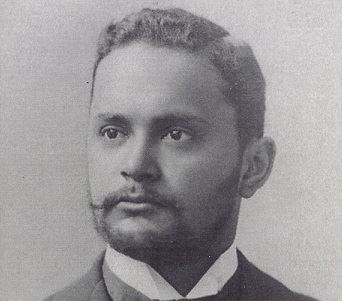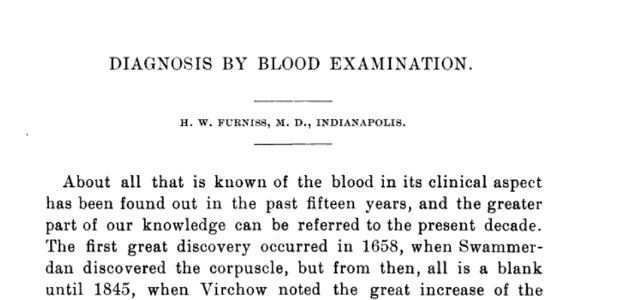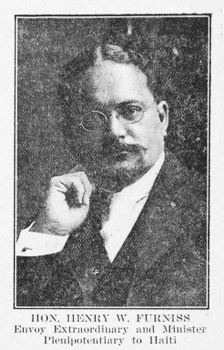by Norma Erickson
Henry Watson Furniss’s life could have been one more example of a brilliant Black physician who could not reach his full potential because of the barriers imposed by 19th and 20th century racial segregation. His story can be summed up not as career opportunities denied, but rather his was marked with achievements driven by ability, ambition, and being in the right place at the right time.
Furniss was born in Brooklyn, New York, in 1868 to a highly educated African American couple, whose ancestors also included relatives of European origin.* Not long after his birth, his father William Henry Furniss was appointed the Assistant Secretary of State of Mississippi. He moved his wife, Caroline Williams Furniss, and young Henry to the capital city of Jackson, where little brother Sumner was born in 1874. In just a few years, Reconstruction would end in 1877 and the Federal troops that provided protection for Blacks trying to advance politically and economically in the South were withdrawn. The family remained in Mississippi until around 1880, then settled in Indianapolis, where the Furniss men thrived in the community. The boys attended high school at Indianapolis High School, and ultimately both went on to study medicine in local medical colleges. Their father scored the highest grade on the postal clerk exam and was placed in charge of a post office department. Their mother also had a teaching career, and the entire family became part of the elite of the African American community of Indianapolis. 
Rather than immediately establishing a medical practice in Indianapolis after graduation, Henry went east for further study at Howard Medical School, the Harvard Medical School master’s program, the New York Post Graduate School, and the PhD in Pharmacology program at NYU. His medical experience began with a surgical internship at Freedman’s Hospital in Washington, DC, in 1895. When he returned to Indianapolis in 1896, he was likely one of the most highly-trained physicians in the city at that time—Black or White.

Besides his academic medical achievements, he also returned to Indianapolis with connections made in Washington that would lead to a career in diplomatic service for the US. In 1897, he was appointed by President William McKinley to be Consul to the Brazilian state of Bahia, one of the few diplomatic positions open to Blacks at the time. His mission there was to provide information to the US State Department and American companies who might have an interest in establishing businesses in Brazil. He learned Portuguese, traveled the countryside widely, and wrote detailed reports back to the States. His experience as a physician resulted in extensive information about public health issues in the locale being sent back to the States.
 Late in 1905, Furniss was appointed US Minister to Haiti by President Theodore Roosevelt, a post traditionally given to Blacks since 1862. Connections with Roosevelt’s Vice President, Hoosier Charles M. Fairbanks, might also have pushed his appointment forward. He left Bahia with years of valuable diplomatic experience that would carry him through the service ahead of him. He also landed in Haiti with a white German-born wife. Both would impose barriers and produce advantages, depending on the time and place. His diplomatic service ended in 1913.
Late in 1905, Furniss was appointed US Minister to Haiti by President Theodore Roosevelt, a post traditionally given to Blacks since 1862. Connections with Roosevelt’s Vice President, Hoosier Charles M. Fairbanks, might also have pushed his appointment forward. He left Bahia with years of valuable diplomatic experience that would carry him through the service ahead of him. He also landed in Haiti with a white German-born wife. Both would impose barriers and produce advantages, depending on the time and place. His diplomatic service ended in 1913.
Henry wed Anna Wichmann in London, England, in October of 1903. She was the daughter of a wealthy German businessman and maintained ties with family in Hamburg. The Furnisses had three children in Haiti, but their firstborn died of tropical dysentery shortly after his first birthday. His term in Haiti ended in 1913, but the family remained there until about 1917. Henry did not return to Indianapolis to practice medicine with his brother as he did in 1896. On one hand, Indiana had strict miscegenation laws; putting down roots with a white wife and two mulatto children in tow would be difficult. The situation promised no improvement, as Indiana was beginning to enter its active Ku Klux Klan decade. On the other, the Black community was not especially pleased that one of their most successful sons had married outside of its circle.
The family returned to the US, settling in the West Hartford, Connecticut area, where Dr. Furness set up a urology practice. The barriers he might encounter because of his Blackness held less importance in his life there. In some respects, a more liberal northeastern community may have made the family’s acceptance better. Also around this time, he was received differently for one very important reason—he ultimately began to identify as white. His son, William, who was listed as Black when he attended Tufts University Medical School, also assumed a different life—passing as a white man when enlisting in the army and serving as a flight surgeon in WWII.
Fluent in English, German, and Portuguese, Furniss was a 33rd degree Mason, a member of the American Society of International Law, the American Microscopical Society, and the American Medical Association. Furniss passed away in 1955, aged 87. His death certificate identified him as White.
(Furniss's parents were sometimes described with the ethnic designation commonly used at the time--mulatto. This is considered a derogatory term today and rightly so because of its origin in slavery culture).
Sources:
Happy, Richard and Diane Furniss Happy, Under the Radar: The Little Known Story of Dr. Henry Watson Furniss, An African-American Pioneer. (Middletown, DE, 2020)
Transactions of the Indiana State Medical Association, Issue 48, p. 291
Who’s Who of the Colored Race, Vol.1, 1915
Indiana Medical Journal: A Monthly Journal of Medicine and Surgery, Vol.14, p.453
Fredrick Douglass and American Empire in Haiti, https://reparationscomm.org/reparations-news/editors-choice/frederick-douglass-and-american-empire-in-haiti/#:~:text=At%20the%20age%20of%20seventy,reward%20for%20the%20elderly%20abolitionist, accessed 2/14/2022
Photos:
1) Henry W. Furniss, MD (Photo from cover of Under the Radar: The Little Known Story of Dr. Henry Watson Furniss, An African-American Pioneer)
2)Caption: Furniss was the first Black physician to deliver a paper at an Indiana State Medical Association annual meeting. (Transactions of The Indiana State Medical Association, Issue 48, p. 291,Forty-eighth Annual Session, 1897, Terre Haute, Indiana.)
3) Henry W. Furniss, Envoy to Haiti, courtesy of the New York